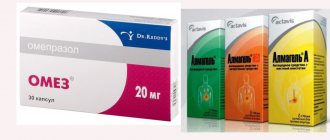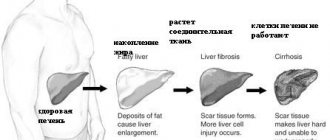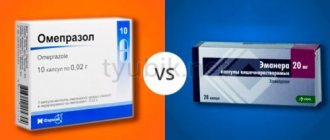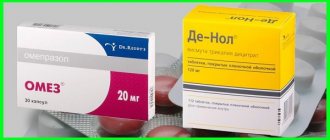Instructions
Emanera or Nolpaza are used to reduce the concentration of hydrochloric acid in the stomach. The drugs are prescribed for ulcers and gastroesophageal reflux. They are also taken during Helicobacter eradication.
Emanera or Nolpaza are used to reduce the concentration of hydrochloric acid in the stomach.
Emanera
Esomeprazole is the active component of Emanera. A new generation drug for the treatment of gastrointestinal ulcers. Minimizes the production of hydrochloric acid in the stomach, treats inflammatory, erosive, and ulcerative diseases.
The medicine is available in capsule form, in blisters of 14 and 28 pieces; contains an active component weighing 20 and 40 milligrams. If the patient is unable to take tablets orally, and there are serious reasons for this, Emanera can be purchased in the form of a lyophilisate for the preparation of intravenous injections.
Doctors' opinions and patient reviews
Yulia, 40 years old, Moscow, gastroenterologist: “Both drugs are effective. Nolpaza is safe, well tolerated by patients, and the effect after taking it lasts for a long time. Side effects during treatment with the drug are rare. This remedy can be taken by people with concomitant pathologies.
Emanera helps to quickly eliminate symptoms. The drug is more convenient to take, because it is available in capsules. The medicine is prescribed to patients who have problems with swallowing. In this case, the contents of the capsule are dissolved in water.”
Irina, 35 years old, Perm: “I was worried about stomach pain, bad breath, heartburn. FGDS showed the presence of superficial gastroduodenitis. The doctor prescribed Nolpaza. I took 1 tablet 30 minutes before breakfast. The course of treatment was 14 days. After 2 weeks of taking the drug, the pain went away and heartburn disappeared. My stomach has completely stopped bothering me. 5 days after completion of treatment, the bad breath disappeared.”
Svetlana, 28 years old, Saratov: “Several years ago we were diagnosed with reflux esophagitis. During exacerbations, the doctor recommended taking Emanera. I buy the drug in dosages of 20 and 40 mg. In the first case, take 2 capsules 20 minutes before breakfast, and in the second, 1 capsule. The product begins to act quickly. The pain immediately dulls, heartburn goes away, and digestion improves. The drug is effective, however, it may cause side effects. After taking it I feel dizzy. During the day you need to drink more water, because... The medicine causes dry mouth.”
Pharmacological action of drugs
Both drugs have a similar principle of action on the body. The active components act as blockers for the cellular channel located on the gastric mucosa for the synthesis of hydrogen ions, which contribute to the production of hydrochloric acid in the stomach. To treat ulcerative lesions and erosions, it is necessary to maintain a certain level of acidity. Like a pump, the medicine interferes with the release of stomach enzymes, reducing acid levels and helping wounds heal.
Nolpaza and Emanera are absorbed into the body, their metabolism takes place in the liver, the metabolites are excreted mostly through the kidneys with urine, and less through the intestines with bile.
Comparison of safety of Omez and Emanera
The safety of a drug includes many factors.
At the same time, in Omez it is quite similar to Emanera. It is important where the drug is metabolized: drugs are excreted from the body either unchanged or in the form of products of their biochemical transformations. Metabolism occurs spontaneously, but most often involves major organs such as the liver, kidneys, lungs, skin, brain and others. When assessing metabolism in Omez, as well as in Emanera, we look at which organ is the metabolizing organ and how critical the effect on it is.
The risk-benefit ratio is when the prescription of a drug is undesirable, but justified under certain conditions and circumstances, with the obligatory observance of caution in use. At the same time, Omez does not have any risks when used, just like Emanera.
Also, when calculating safety, it is taken into account whether only allergic reactions occur or possible dysfunction of the main organs. In other matters, as well as the reversibility of the consequences of using Omez and Emanera.
When are medications prescribed?
Emanera and Nolpaza treat the following diseases:
- Zollinger-Ellison syndrome with increased secretion of gastric juice;
- gastroesophageal reflux disease GERD, accompanied by heartburn and acid belching;
- peptic ulcer of the stomach and duodenum;
- erosive-inflammatory processes caused by long-term use of non-steroidal drugs;
- peptic ulcer;
- gastritis and hypersecretion of gastric acid, which appeared for the first time;
- reflux – esophagitis of various forms;
- destruction of Helicobacter pylori bacteria by combined therapy with two antibacterial drugs.
Emanera is prescribed for a year to prevent recurrence of GERD.
PPIs in the treatment of gastrointestinal diseases
Have you been struggling with GASTRITIS and ULCERS for many years without success?
Head of the Institute: “You will be amazed at how easy it is to cure gastritis and ulcers simply by taking it every day.
PPIs, or proton pump inhibitors, belong to a group of pharmacological drugs used in the treatment of gastric pathologies. Medicines quickly eliminate symptoms caused by excess production of hydrochloric acid. Modern representatives of PPIs are most effective: Rabeprazole, Omeprazole, Lansoprazole, Pantoprazole and Esomeprazole. They are used as part of complex treatment of various types of gastritis and ulcerative lesions. Before prescribing proton pump inhibitors, the gastroenterologist studies the results of laboratory and instrumental studies. When prescribing dosages and determining the duration of treatment, the doctor takes into account the general health of the patient and the presence of diseases in the anamnesis.
Features of pharmacological drugs
Our readers successfully use Monastic Tea to treat gastritis and ulcers. Seeing how popular this product is, we decided to bring it to your attention. Read more here...
For a long time, antacids were used to increase the pH of gastric juice. When entering the human body, the active ingredients of the drugs enter into a chemical reaction with hydrochloric acid. The resulting neutral products are eliminated from the digestive tract with each bowel movement. But antacids have serious disadvantages:
- lack of long-term therapeutic effect;
- failure to address the underlying cause of the disease.
Therefore, the synthesis of the first representative of proton pump inhibitors (Omeprazole) made a breakthrough in the treatment of ulcers and gastritis. While antacids help reduce the level of hydrochloric acid already produced, PPIs prevent its production. This allows you to avoid the development of dyspeptic disorders in a person - excessive gas formation, nausea, vomiting, heartburn and sour belching. An undoubted advantage of proton pump inhibitors is the ability to maintain the maximum therapeutic concentration in the systemic circulation for a long time. Only after 15-20 hours do the parietal cells of the stomach begin to produce hydrochloric acid again.
Activation of PPI representatives in the digestive tract requires different times:
- Rabeprazole has the fastest therapeutic effect;
- Pantoprazole has the slowest effect.
Proton pump inhibitors also have common properties. For example, after penetration into the gastrointestinal tract, all PPIs suppress the production of caustic acid by more than 85%.
Warning: “When choosing a drug for the treatment of gastritis or ulcerative lesions, doctors take into account the individual sensitivity of patients to the active substance of a particular proton form inhibitor. It manifests itself in a rather peculiar way - even with recent use of tablets, the pH of gastric juice decreases sharply. This acid concentration is determined within about an hour, and then there is a sharp improvement in the person’s well-being.”
The effect of drugs in the human body
PPIs are precursor drugs. The therapeutic effect begins only after the addition of a hydrogen proton to them in the gastrointestinal tract. The active form of the drugs acts directly on the enzymes responsible for the production of hydrochloric acid. Proton pump inhibitors do not immediately begin to exhibit their therapeutic properties, but only as the main compounds accumulate in tissues and are converted into sulfenamides. The rate at which hydrochloric acid production decreases may vary depending on the type of drug.
But such a difference is possible only in the first days of using PPIs. In the course of clinical studies, it was proven that after a week of using any proton pump inhibitors, their therapeutic effectiveness levels off. This becomes possible due to the similar chemical composition of the drugs. All PPIs are substituted benzimidazole derivatives and are formed as a result of a weak acid reaction. After activation in the small intestine, the drugs begin to affect the glandular cells of the gastric mucosa. It happens like this:
- PPIs penetrate the tubules of parietal cells, turning into tetracyclic sulfenamides;
- the proton pump contains cysteine receptors, to which sulfenamides bind via disulfide bridges;
- the action of (H+,K+)-ATPases located on the apical membranes of glandular cells begins to be suppressed;
- the transfer of hydrogen protons into the stomach cavity slows down and then completely stops.
After inhibition of (H+,K+)-ATPase, the production of hydrochloric acid by the cells of the gastric mucosa becomes impossible. Antisecretory therapy is indicated for patients with any form of gastritis, even with low acidity. This is necessary for the rapid regeneration of damaged tissue - the main cause of pain in the epigastric region.
Advice: “Do not skip a PPI dose or interrupt treatment. A prerequisite for rapid tissue regeneration is the constant presence of drugs in the human body. Healing and scarring of ulcerations occurs several weeks after starting proton pump inhibitors.”
All types of proton pump inhibitors
Gastroenterologists use five representatives of proton pump inhibitors, differing from each other in active ingredients, to treat gastrointestinal pathologies. If one PPI is ineffective, the doctor replaces it with another drug. On the shelves of pharmacies, each type of antisecretory agent is represented by many structural analogues of Russian and foreign production. They may have serious price differences, despite the same dosages and number of capsules.
When choosing between analogues of one of the PPI representatives, the gastroenterologist often recommends a more expensive drug to the patient. You should not accuse the doctor of any self-interest - such a preference is justified in most cases. For example, the Russian drug Omeprazole has analogues:
- Indian Omez;
- Ultop made in Slovenia.
Many patients will not feel a difference when taking these drugs, since they exhibit approximately the same therapeutic effect. But for some people, recovery will occur after a course of treatment with Ultop. This is explained not only by the quality of the active ingredient, but also by the various auxiliary ingredients used to form capsules and tablets. Proton pump blockers are drugs that require an individual approach when prescribing dosages and duration of course treatment.
Omeprazole
Omeprazole is the most common and widely used proton pump inhibitor in the treatment of gastrointestinal pathologies. It stops inflammatory processes on the mucous membranes and promotes rapid regeneration of damage. Its effectiveness has been proven in the treatment of patients diagnosed with a malignant neoplasm in the stomach, which provokes increased production of hydrochloric acid. Omeprazole significantly enhances the bactericidal effect of antibiotics when administered simultaneously. An hour after taking the drug, its maximum concentration is detected in the blood, which persists for 2.5-4 hours.
Similarities of drugs
Both drugs are proton pump inhibitors.
The medication intake is the same and follows the following scheme:
- Swallow the tablet/capsule whole, do not chew it, and wash it down with regular drinking water. The product is consumed in the morning before meals. If a double dose is prescribed, divide the dose into two parts: drink the first in the morning before breakfast, the second in the evening before dinner.
- If you have problems swallowing, the contents of the capsule should be diluted with water. Usually one or two tablets of the drug are prescribed. The dosage should take into account the complexity of the disease and the patient’s sensitivity to the elements of the drugs.
The active substance of the drugs is susceptible to the acidic gastric environment. It is enclosed in an enteric coating, which passes through an acidic environment, enters the intestine and begins to dissolve in it, distributing pantoprazole or esomeprazole throughout the small intestine, where absorption of the components through the mucosa begins. Substances then accumulate in the blood and show their activity in the gastric tubules.
Both drugs can be taken for preventive purposes - they can have a protective effect against gastrointestinal diseases.
The medications are relatively safe and can be taken over a long period of time. The course of therapy should be prescribed by a doctor, taking into account the characteristics of the disease.
Both drugs can be purchased at pharmacies strictly according to a doctor's prescription.
Contraindications for use
Emanera should not be taken in the following cases:
- hypersensitivity to the components of the drug;
- use of nelfinavir or atazanavir;
- food inherited fructose intolerance;
- glucose-galactose malabsorption;
- disaccharidase deficiency.
The drug has age restrictions. It is not prescribed to children under 12 years of age. At an older age, it should not be taken for indications that are not in the instructions for the product.
Contraindications to the use of Nolpaza:
- pregnancy;
- lactation;
- simultaneous use of atazanavir;
- intolerance to the components of the product;
- childhood;
- neurotic dyspepsia;
- inherited fructose intolerance.
The drug is used with caution in case of liver failure, in the treatment of elderly people, when taking ritonavir.
Differences
Despite the same pharmacology, drugs have different compositions and active ingredients. In this regard, each drug has its own disadvantages and advantages.
- Emanera has its maximum effect one to two hours after administration, it is more bioavailable, and reduces the production of hydrochloric acid by 97%. Nolpaza is less bioavailable, is active two hours after ingestion, acid secretion is reduced by 90%.
- The Emanera substance quickly breaks down into ions and is absorbed; the higher the bioavailability index, the more actively the medicine works. Esomeprazole is able to cope with stomach ulcers faster; it is considered a stronger blocker of hydrochloric acid secretion. The therapeutic effect is noticeable already on the fourth day, while the effect of pantoprazole is noticeable after seven days.
- The cost of emanera is slightly more expensive compared to nolpaza.
- Nolpaza should not be taken by children and adolescents from zero to eighteen years of age. Emanera can be prescribed to adolescents as young as twelve years of age.
Which is better Pantoprazole or Omeprazole
Different proton pump inhibitors form active forms at different rates. To answer the question of which is better Pantoprazole or Omeprazole, it is necessary to consider the main characteristics of the drugs. It is better to start comparing drugs with general qualities:
- Indications.
- Contraindications. Pantoprazole, Omeprazole and other drugs of the group (Lansoprazole, Esomeprazole, Rabeprazole) are not prescribed to pregnant and lactating women, as well as to children.
- Side effects.
Key differences
The first pharmacokinetic difference is that the bioavailability of Pantoprozole is 77%, while its “competitor” is absorbed by only 35% upon initial administration. The maximum concentration of Omeprazole is observed after 0.5 hours. Pantoprazole - after 2 hours.
Studies of the antisecretory effect have made it possible to find out how one drug differs from the second. In the same dosages, the effect of medicinal products is different. Pantoprazole is inferior in effectiveness to Omeprazole.
There is a difference in the rates of removal of residual products. Omeprazole is eliminated faster. A comparison between two inhibitors would not be complete without taking into account the specific effects on the body. Pantoprazole has a milder effect, inhibits the secretion of hydrochloric acid more slowly, and not as strongly as its analogues.
Side effects
Adverse reactions are somewhat different; pantoprazole has more of them. All of them appear in rare cases, however, if you observe and receive an undesirable reaction of the body to the drug, you should stop using the drugs and seek help and advice from your doctor.
With long-term use of Emanera, it can be noted that:
- calcium is poorly absorbed, in this condition the risk of developing osteoporosis and bone fracture increases;
- absorption of vitamin B12 occurs slowly and with disturbances, reducing the body’s protective shell during periods of stress and illness, brain activity is disrupted;
- the amount of magnesium in the blood decreases, which leads to neuroses, irritability and chronic fatigue;
- glandular cysts form in the stomach - benign neoplasms that interfere with the digestion process and cause discomfort in the stomach.
Nolpaza causes the following side effects:
- allergic reactions such as rash, itching, redness of the skin, Stevens-Johnson syndrome, Lyell's syndrome, and sometimes anaphylactic shock;
- dizziness and severe headaches;
- pain in joints and muscles;
- diarrhea, constipation, digestive disorders due to stress and depression, so-called dyspepsia of neurotic origin;
- development of thrombocytopenia with a low level of platelets and leukopenia with a reduced number of leukocytes.
- blurred vision (blurred and blurred vision).
Ranitidine or Omeprazole, which is better?
Ranitidine and Omeprazole reduce the secretion of hydrochloric acid and are used for corresponding diseases of the gastrointestinal tract. Their main difference is in the mechanism of operation. While the second drug blocks the proton pump, Ranitidine acts on histamine H2 receptors and prevents acid from being synthesized in response to histamine, gastrin and acetylcholine. It works in less time: the effect lasts for 12 hours, which leads to the daily dose being divided into 2 or 3 doses. The proton pump blocker has the advantage of having a bactericidal effect against Helicobacter pylori.
During pregnancy and breastfeeding, you can only take Omeprazole.
A distinctive contraindication for Omeprazole is chronic liver disease. Ranitidine has more side effects: it additionally affects the endocrine system, and when administered intravenously, it can cause AV block. Another medicine, in turn, can lead to the appearance of protein and blood in the urine.
After discontinuation of Rantidine, secretion in the stomach sometimes increases. The medicine is considered more outdated. Omeprazole is superior in effectiveness, although some patients are resistant to treatment with these capsules.
Special instructions and recommendations
Different active substances act differently depending on the type of disease. In some cases, doctors prescribe Nolpaza, in others - Emanera, so as not to harm the patient and not aggravate the development of the underlying disease.
- If the underlying disease is epilepsy, then esomeprazole should not be used in its treatment.
- For the treatment of cardiovascular diseases, together with drugs that prevent the formation of blood clots, in the presence of ulcer formation, it is recommended to take pantoprazole.
- Patients with liver dysfunction should monitor the activity of liver enzymes during therapy with antiulcer drugs.
- Renal failure is considered a serious complication of the use of pantoprazole and esomeprazole; such patients should take medications with caution under the strict supervision of a specialist.
- Both drugs are prescribed after endoscopic or ultrasound examination of the gastric and duodenal mucosa. The examination helps to identify a more serious gastrointestinal disease with symptoms of gastritis.
- It is not recommended to take medications during lactation. If the need arises, the child should be transferred to artificial feeding with infant formula instead of mother's milk, since medications can enter the baby's body along with mother's milk and cause dangerous complications in the child's unformed body.
Nolpaza, Emanera or another anti-ulcer drug cannot be better or worse. There is no clear answer, just as no two patients are alike. The choice of medicine should be appropriate to the disease.
A correct diagnosis, the pharmacological action of drugs, the individual characteristics of the patient’s body - everything must be taken into account in order to help the patient cope with the disease in the shortest possible time without complications and undesirable consequences.
Comparison of addiction between Omez and Emanera
Like safety, addiction also involves many factors that must be considered when evaluating a drug.
So, the totality of the values of such parameters as “o syndrome” in Omez is quite similar to the similar values in Emanera. Withdrawal syndrome is a pathological condition that occurs after the cessation of intake of addictive or dependent substances into the body. And resistance is understood as initial immunity to a drug; in this it differs from addiction, when immunity to a drug develops over a certain period of time. The presence of resistance can only be stated if an attempt has been made to increase the dose of the drug to the maximum possible. At the same time, in Omez the meaning of the “syndrome” is quite small, however, the same as in Emanera.
Advantages of Pariet over similar drugs
The advantage of rabeprazole over its analogues is that it acts on the root cause of heartburn, and does not simply remove the symptom. Heartburn occurs as a result of the reflux of hydrochloric acid into the esophagus. With the participation of Pariet, hydrochloric acid is produced directly in the stomach, without irritating the esophagus.
Compared to other medications, rabeprazole has the following advantages:
- during the first 3 hours: regulation of acid production, effects on parietal cells of the gastrointestinal tract,
- after 3 hours: reducing stomach acidity, maintaining its normal level.
- acid production is blocked for 2 days, there is no reflux of acid into the esophagus,
- During the day, the walls of the esophagus are protected by natural mucus, the secretion of which is stimulated by the drug.
When using antacids, the synthesized acid is neutralized, but its production continues, and the symptom returns again after a short time. As its concentration increases and enters the esophagus, the patient again feels heartburn.
Comparison of Pariet with other drugs
The opinions of gastroenterologists agree: there is no convincing information regarding the better effectiveness of Pariet over other drugs from the proton pump group.
Each of the drugs has a stated pharmacological effect and can be used in multicomponent treatment regimens, taking into account the indications for use, the presence of associated complications, and the general condition of the patient.
When comparing Pariet with other proton pump inhibitors (PPIs) for long-term treatment of gastroesophageal reflux disease, doctors made the following conclusions:
- medications based on lansoprazole begin to act faster than rabeprazole (Pariet),
- When using combination treatment, which involves taking several groups of drugs, pantoprazole-based drugs are the safest.
A number of doctors are also convinced that the inclusion of PPIs, including Pariet and its analogues, in multicomponent treatment regimens for gastric ulcers caused by Helicobacter pylori does not play a significant therapeutic role. Without the concomitant use of antibiotics, treatment will be ineffective.
Which is better: Nolpaza or Pariet?
Both drugs have similar indications for use, but differ in composition. The active substance of Nolpaza is pantoprazole. Nolpaza can be used in the treatment of pregnant and lactating women, while taking Pariet is contraindicated in such groups of patients.
Nolpaza has a large list of contraindications. Tablets can be purchased upon presentation of a prescription.
Both raboprazole and pantoprazole are able to bind hydrogen ions and bind to the carrier molecule. This effect leads to normalization of hydrochloric acid levels. Nolpaza has a wider range of dosage forms: in addition to tablets of 20 and 40 mg, it is also available in the form of a lyophilisate for the preparation of a solution for injection.

Nexium or Pariet: what to choose?
Both drugs belong to the group of proton pump inhibitors, but differ in composition. The active component of Nexium (esomeprazole) is an omeprazole derivative.
The mechanism of action of Nexium and Pariet is similar: both drugs take part in reducing the production of hydrochloric acid.
Nexium is prescribed to patients for the correction of disorders caused by prolonged use of non-steroidal anti-inflammatory drugs:
- for healing ulcerative lesions,
- for the prevention of gastric and duodenal ulcers.
Difference between Hairabezol and Pariet
Khairabezol is an Indian drug that is presented in the form of tablets coated with a soluble coating. The main difference in the drugs is in the production technology. Despite the similar active ingredient, the auxiliary components are different. Other differences:
- Khairabezol is a more affordable medicine. This can be a compelling argument for patients who are indicated for a long course of treatment.
- Hairabazole has a wide variety of release forms, including packs of 100 tablets. Buying one tablet of medicine from a common, large package is even more affordable. Hospitals have the opportunity to purchase the product in packages of 100, 300 and 500 pcs.
- The active substance and auxiliary components of Pariet are of high quality. The composition is selected in such a way as to minimize the likelihood of adverse reactions, including allergies.
- After stopping short-term use of Pariet, the concentration of hydrochloric acid remains within normal limits for a week, Omez - for 3-4 days.
- Rabeprazole-based drugs begin to act faster than omeprazole.
- Omez often causes adverse reactions from the liver.
- The active component of Omeza exhibits its pharmacological properties when interacting with the acidic environment of the stomach.
- Omeprazole is a prescription drug.
- blurred vision,
- asthenic syndrome,
- depression,
- peripheral edema,
- flu-like condition
- infectious lesions,
- increased excitability,
- sleep disorders.
When selecting a medicine, it is recommended to take into account the cost, pay attention to the composition, list of contraindications, side effects. both drugs are not prescribed to patients under 12 years of age.
Rabeprazole
Rabeprazole is the active component of Pariet, one of the most inexpensive analogues of the original medicine. It has a low cost, but is not always well tolerated by patients. May be dangerous for allergy sufferers. People with hypersensitivity to drugs are advised to pay attention to higher quality analogues of Pariet.
Rabeprazole is started with the minimum effective dose and the therapeutic effect and the body’s reaction are observed. If unwanted side effects rapidly develop or there is no proper therapeutic result, Rabeprazole is discontinued and another medication is selected.
Omeprazole (Omez) and Pariet - comparison of drugs
Omeprazole (Omez) and Pariet are drugs from the same pharmacological group, but with different compositions. The difference is both in the form of release and in the amount of the drug in the package. 10 or 30 tablets of Pariet and 7, 14, 28 capsules of Omez (Omerpazole).
Despite the difference in composition, the mechanism of action of the active substances is similar. It is based on the possibility of inhibiting the proton pump and reducing the activity of the enzyme that regulates the interaction between potassium and hydrogen.
The advantage of Pariet is that it can be used in a smaller dose to achieve a therapeutic effect similar to Omez. If we take into account affordability, then omeprazole has all the advantages.
Zulbex
Zulbex is not the most budget-friendly substitute for Pariet. Similar in composition and release forms (tablets 10, 20 mg).
As with the original medicine, Zulbex is not prescribed to children under 12 years of age. The list of possible contraindications for both drugs is similar.
The instructions indicate that Zulbex has a more extensive list of possible adverse reactions. Additional reactions are possible in the form of:
What analogues of Omez are better: how to replace Omez?
Omez is an excellent antiulcer drug. Due to the presence of contraindications, it is not suitable for all patients. Is there a substitute for Omez? This is a pressing question that can be answered with confidence in the affirmative. Many doctors and patients note the high effectiveness of drug analogues.
What is the difference between analogues and Omez
Lately, many people have been trying to purchase analogues of drugs due to the high price of original drugs. As for effectiveness: some substitutes are absorbed better by the body, others may be ineffective. Everything is purely individual.
Why generics are cheaper:
- Inexpensive raw materials are used.
- No money is spent on clinical trials.
How to choose an analogue
Most people want a highly effective drug at an affordable price.
When choosing a generic, you need to pay attention to the following criteria:
- onset of action, bioavailability;
- presence of contraindications;
- dosage, frequency of use;
- release form;
- price;
- duration of treatment;
- efficiency.
A possible analogue can be easily found in any pharmacy.
Analogs
If we talk about generics, then their active ingredient is similar to the original - omeprazole.
The table shows Omez substitutes in different forms, with different active ingredients
| № | Name | Release form | Active substance |
| 1. | De-nol | pills | Bismuth tripotassium dicitrate |
| 2. | Ranitidine | tablets, powder for injection | Ranitidine |
| 3. | Nexium | capsules, tablets, powder | Esomeprazole |
| 4. | Zulbex | pills | Rabeprazole sodium |
| 5. | Nolpaza | tablets, powder | Pantoprazole |
Before replacing Omez, you should consult your doctor.
Which is better Ranitidine or Omez
Ranitidine is not a proton pump inhibitor like omeprazole, but is a medication from the group of histamine type 2 receptor blockers. It is also used to reduce the level of hydrochloric acid during exacerbations of chronic gastritis, peptic ulcer; used as a preventive measure.
Ranitidine should be treated with caution, since its sudden cessation can provoke a relapse of peptic ulcer disease. Only the attending physician prescribes and discontinues the drug.
Contraindications to the medicine:
- childhood;
- pregnancy (early stages);
- lactation period;
- liver diseases;
- allergy to the components of the drug.
When treating with this drug, you need to know that other medications can be taken at least 2 hours later. When used simultaneously with antacids, the effectiveness of the drug may be reduced.
When comparing these two drugs, preference should be given to Omez. Ranitidine is an older drug to which many people have developed resistance. However, many doctors successfully use it to treat diseases of the duodenum and stomach.









